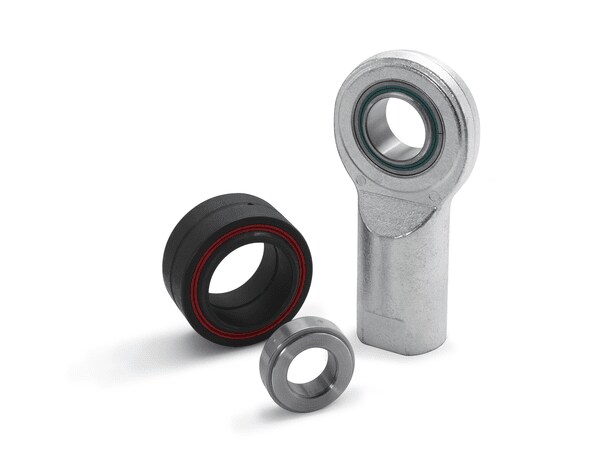Spherical plain bearings and rod ends
Bearing types

Maintenance-free radial spherical plain bearings with sliding contact surface combination steel/PTFE sintered bronze (table 3) and those with steel/PTFE fabric (table 4) are suitable for heavy, constant direction loads, where low friction is required. They have a limited suitability for alternating loads as well as shock loads.
Bearings with sliding contact surface combination steel/PTFE FRP (table 5) are suitable for heavy, constant direction loads, where low friction is required. They have a limited suitability for alternating loads as well as shock loads and they are relatively insensitive to contaminants.
Angular contact spherical plain bearings (table 6) are available with sliding contact surface combination steel/PTFE FRP which are suitable for single direction axial loads or combined axial and radial loads. They have low coefficient of friction and are relatively insensitive to contaminants.
Bearings with sliding contact surface combination steel/PTFE fabric are suitable for single direction axial loads or combined axial and radial loads. They have very high load carrying capacity and low coefficient of friction.
Angular contact spherical plain bearings with sliding contact surface combination steel/steel are suitable for heavy single direction axial loads or heavy combined axial and radial loads as well as heavy alternating loads.
Thrust spherical plain bearings (table 7) are available with sliding contact surface combination steel/PTFE FRP which are suitable for single direction axial loads or combined axial and radial loads. They have low coefficient of friction and are relatively insensitive to contaminants.
Bearings with sliding contact surface combination steel/PTFE fabric are suitable for heavy single direction axial loads or combined axial and radial loads. They have very high load carrying capacity and low coefficient of friction.
Thrust spherical plain bearings with sliding contact surface combination steel/steel are suitable for heavy single direction axial loads or combined axial and radial loads as well as heavy alternating loads.
Rod ends with a threaded shank requiring maintenance are available with sliding contact surface combination steel/steel (table 8). They are suitable for heavy static or alternating loads as well as shock loads.
Rod ends with a slotted shank (table 9) can be secured by tightening bolts and are therefore suitable for hydraulic cylinders.
Rod ends with sliding contact surface combination steel/bronze (table 10) have lower load carrying capacity compared to steel/steel rod ends, but are more suitable for applications where lubricant starvation might occur.
Rod ends with a welding shank are available with sliding contact surface combination steel/steel (table 11). They are suitable for heavy static or alternating loads as well as shock loads.
